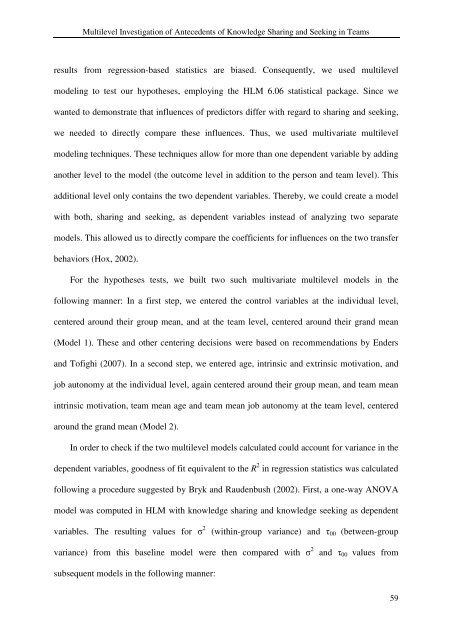thesis_Daniela Noethen_print final - Jacobs University
thesis_Daniela Noethen_print final - Jacobs University
thesis_Daniela Noethen_print final - Jacobs University
You also want an ePaper? Increase the reach of your titles
YUMPU automatically turns print PDFs into web optimized ePapers that Google loves.
Multilevel Investigation of Antecedents of Knowledge Sharing and Seeking in Teams<br />
results from regression-based statistics are biased. Consequently, we used multilevel<br />
modeling to test our hypotheses, employing the HLM 6.06 statistical package. Since we<br />
wanted to demonstrate that influences of predictors differ with regard to sharing and seeking,<br />
we needed to directly compare these influences. Thus, we used multivariate multilevel<br />
modeling techniques. These techniques allow for more than one dependent variable by adding<br />
another level to the model (the outcome level in addition to the person and team level). This<br />
additional level only contains the two dependent variables. Thereby, we could create a model<br />
with both, sharing and seeking, as dependent variables instead of analyzing two separate<br />
models. This allowed us to directly compare the coefficients for influences on the two transfer<br />
behaviors (Hox, 2002).<br />
For the hypotheses tests, we built two such multivariate multilevel models in the<br />
following manner: In a first step, we entered the control variables at the individual level,<br />
centered around their group mean, and at the team level, centered around their grand mean<br />
(Model 1). These and other centering decisions were based on recommendations by Enders<br />
and Tofighi (2007). In a second step, we entered age, intrinsic and extrinsic motivation, and<br />
job autonomy at the individual level, again centered around their group mean, and team mean<br />
intrinsic motivation, team mean age and team mean job autonomy at the team level, centered<br />
around the grand mean (Model 2).<br />
In order to check if the two multilevel models calculated could account for variance in the<br />
dependent variables, goodness of fit equivalent to the R 2 in regression statistics was calculated<br />
following a procedure suggested by Bryk and Raudenbush (2002). First, a one-way ANOVA<br />
model was computed in HLM with knowledge sharing and knowledge seeking as dependent<br />
variables. The resulting values for σ 2<br />
(within-group variance) and τ 00 (between-group<br />
variance) from this baseline model were then compared with σ 2<br />
and τ 00 values from<br />
subsequent models in the following manner:<br />
59

















